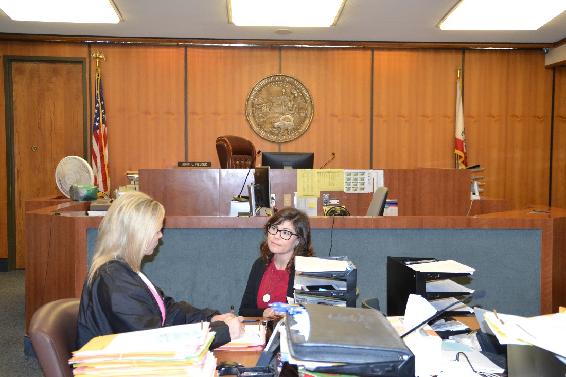10.1: Public agencies
- Page ID
- 16143
Correctional officers are responsible for overseeing individuals who have been arrested and are awaiting trial or who have been sentenced to serve time in jail or prison. Bailiffs, also known as marshals or court officers, are law enforcement officers who maintain safety and order in courtrooms. Their duties, which vary by court, include enforcing courtroom rules, assisting judges, guarding juries, delivering court documents, and providing general security for courthouses.

Figure 10.1 Superior Court County of Kern by Tabitha Raber is used under a CC BY 4.0 license.
Think about It . . . Serving 9 to 5: A Correctional Officer's Diary (NPR)
“To work in a prison you have to be a special type of person”
Sergeant Furman Camel spent 27 years in a North Carolina Prison, that’s as many years as Nelson Mandela spent behind bars. But Camel did his time, as he likes to say, in 8 hour shifts.
“I wear this uniform with pride. Every day that I come in here I’m creased down. My shoes are shined. And I smell good. The uniform is 90% of the job. Looking the part.”
Listen to Camel’s story and more audio diaries from officers who work behind bars at the Polk Youth Institution in North Carolina.
Duties
Correctional officers typically do the following:
- Enforce rules and keep order within jails or prisons
- Supervise activities of inmates
- Inspect facilities to ensure that they meet security and safety standards
- Search inmates for contraband items
- Report on inmate conduct
- Escort and transport inmates
Bailiffs typically do the following:
- Ensure the security of the courtroom
- Enforce courtroom rules
- Follow court procedures
- Escort judges, jurors, witnesses, and prisoners
- Handle evidence and court documents

Figure 10.2 Probation Officer in the Court by Tabitha Raber is used under a CC BY 4.0 license.
Inside the prison or jail, correctional officers enforce rules and regulations. They maintain security by preventing disturbances, assaults, and escapes, and by inspecting facilities. They check cells and other areas for unsanitary conditions, contraband, signs of a security breach (such as tampering with window bars and doors), and other rule violations. Officers also inspect mail and visitors for prohibited items. They write reports and fill out daily logs detailing inmate behavior and anything else of note that occurred during their shift.
Correctional officers may have to restrain inmates in handcuffs and leg irons to escort them safely to and from cells and to see authorized visitors. Officers also escort prisoners to courtrooms, medical facilities, and other destinations.
Bailiffs’ specific duties vary by court, but their primary duty is to maintain order and security in courts of law. They enforce courtroom procedures that protect the integrity of the legal process. For example, they ensure that attorneys and witnesses do not influence juries outside of the courtroom, and they also may isolate juries from the public in some circumstances. As a neutral party, they may handle evidence during court hearings to ensure that only permitted evidence is displayed.
Bailiffs held about 18,600 jobs in 2016. The largest employers of bailiffs were as follows:
|
71% |
|
|
29.00% |
Table 10.1 Bailiff Employment
Correctional officers and jailers held about 450,000 jobs in 2016. The largest employers of correctional officers and jailers were as follows:
|
State government, excluding education and hospitals |
54% |
|
Local government, excluding education and hospitals |
37% |
|
Facilities support services |
5% |
|
Federal government |
4% |
Table 10.2. Correctional Officers
Correctional officers may work indoors or outdoors, and bailiffs generally work in courtrooms. They both may be required to stand for long periods. Correctional officers usually work full time on rotating shifts. Because jail and prison security must be provided around the clock, officers work all hours of the day and night, including weekends and holidays. Many officers are required to work overtime. Bailiffs’ hours are determined by when court is in session.
Working in a correctional institution can be stressful and dangerous. Correctional officers may become injured in confrontations with inmates, and they have one of the highest rates of injuries and illnesses of all occupations. The job demands that officers be alert and ready to react throughout their entire shift.
Correctional officers and bailiffs typically attend a training academy. Although qualifications vary by state and agency, all agencies require a high school diploma. Federal agencies may also require some college education or previous work experience. Many agencies establish a minimum age for correctional officers, which is typically between 18 and 21 years of age.
California Department of Corrections Recruitment Video
Select Link Below to Launch Video
Education
Correctional officers and bailiffs must have at least a high school diploma or equivalent.
For employment in federal prisons, the Federal Bureau of Prisons requires entry-level correctional officers to have at least a bachelor’s degree or 1 to 3 years of full-time experience in a field providing counseling, assistance, or supervision to individuals.
Training
Correctional officers and bailiffs complete training at an academy. Training typically lasts several months, but this varies by state. The International Association of Directors of Law Enforcement Standards and Training maintains links to states’ Peace Officer Standards and Training (POST) programs. Academy trainees receive instruction in several subjects, including self-defense, institutional policies, regulations, operations, and security procedures.
Pin It! Correctional Officer Entry Exam Example
Click here for an example of an employment entry exam utilized by the California Department of Corrections and Rehabilitation.
Important Qualities
- Decision making skills. Correctional officers and bailiffs must use both their training and common sense to quickly determine the best course of action and to take the necessary steps to achieve a desired outcome.
- Detail oriented. Correctional officers and bailiffs follow and enforce strict procedures in correctional facilities and courts to ensure everyone’s safety.
- Interpersonal skills. Correctional officers and bailiffs must be able to interact and communicate effectively with inmates and others to maintain order in correctional facilities and courtrooms.
- Negotiating skills. Correctional officers must be able to assist others in resolving differences to avoid conflict.
- Physical strength. Correctional officers and bailiffs must have the strength to physically subdue inmates or others.
- Self-discipline. Correctional officers must control their emotions when confronted with hostile situations.
California Department of Correction - Physical Fitness Test Video
Select Link for Video

